Influence of Increased TaNbV on the Microstructure, Mechanical Properties, and Energy Release Characteristics of High-Entropy Alloy HfZrTi(TaNbV)x
Abstract
1. Introduction
2. Materials and Methods
2.1. Alloy Preparation
2.2. Microstructure Characterization
2.3. Mechanical Properties
3. Results and Discussion
3.1. Microstructure Characteristics
3.2. Mechanical Properties of HZTXx
3.3. SHPB Test of HZTXx Alloy
4. Conclusions
- (1)
- As the content of Ta, Nb, and V was increased, the HZTXx high-entropy alloy underwent a transition in mechanical behavior from ductile to brittle and then back to ductile, accompanying by a phase evolution from a single hexagonal close-packed (HCP) structure to a body-centered cubic (BCC) phase with omega (ω)-phase precipitation, and ultimately to a single-phase BCC structure.
- (2)
- Under quasi-static tension, the profuse precipitation of the ω phase in HZTX0.1 resulted in brittle fracture and low strength, leading to poor tensile properties. As the content of Ta, Nb, and V increased, the grain size was progressively reduced, and the resultant grain refinement endowed the other alloys with improved tensile performance. The concomitant lattice distortion further contributed to an enhancement in yield strength. HZTX0.9 exhibited a yield strength of 1065 MPa, an ultimate tensile strength of 1119 MPa, and a fracture elongation of 16.4%
- (3)
- In the split-Hopkinson pressure bar (SHPB) tests, high-speed imaging revealed that the selected alloys exhibited energy-releasing oxidation reactions under dynamic high-strain-rate loading. The primary mechanism is attributed to the oxidation of active elements (e.g., Hf, Zr) with atmospheric oxygen during the fragmentation process, resulting in visible sparking. The brittle HZTX0.1 alloy fragments more thoroughly, producing finer fragments that facilitate more complete oxidation of the active elements. This results in the earliest observed ignition and the most intense sparking. Meanwhile, the HZTX0.9 alloy exhibits higher strength and superior ductility compared to the base alloy A, while also demonstrating a greater energy release effect. This combination of properties provides key material support for the future development of energetic structural materials.
Author Contributions
Funding
Data Availability Statement
Conflicts of Interest
References
- Miracle, D.B.; Senkov, O.N. A Critical Review of High Entropy Alloys and Related Concepts. Acta Mater. 2017, 122, 448–511. [Google Scholar] [CrossRef]
- Tang, Y.; Wang, R.; Xiao, B.; Zhang, Z.; Li, S.; Qiao, J.; Bai, S.; Zhang, Y.; Liaw, P.K. A Review on the Dynamic-Mechanical Behaviors of High-Entropy Alloys. Prog. Mater. Sci. 2023, 135, 101090. [Google Scholar] [CrossRef]
- Tsai, M.-H.; Yeh, J.-W. High-Entropy Alloys: A Critical Review. Mater. Res. Lett. 2014, 2, 107–123. [Google Scholar] [CrossRef]
- Yeh, J.-W.; Chen, S.K.; Lin, S.-J.; Gan, J.-Y.; Chin, T.-S.; Shun, T.-T.; Tsau, C.-H.; Chang, S.-Y. Nanostructured High-Entropy Alloys with Multiple Principal Elements: Novel Alloy Design Concepts and Outcomes. Adv. Eng. Mater. 2004, 6, 299–303. Available online: https://advanced.onlinelibrary.wiley.com/doi/abs/10.1002/adem.200300567 (accessed on 17 September 2025). [CrossRef]
- Wang, R.; Tang, Y.; Li, S.; Zhang, H.; Ye, Y.; Zhu, L.; Ai, Y.; Bai, S. Novel Metastable Engineering in Single-Phase High-Entropy Alloy. Mater. Des. 2019, 162, 256–262. [Google Scholar] [CrossRef]
- Peng, J.; Li, L.; Li, F.; Liu, B.; Zherebtsov, S.; Fang, Q.; Li, J.; Stepanov, N.; Liu, Y.; Liu, F.; et al. The Predicted Rate-Dependent Deformation Behaviour and Multistage Strain Hardening in a Model Heterostructured Body-Centered Cubic High Entropy Alloy. Int. J. Plast. 2021, 145, 103073. [Google Scholar] [CrossRef]
- Hilhorst, A.; Jacques, P.J.; Pardoen, T. Towards the Best Strength, Ductility, and Toughness Combination: High Entropy Alloys Are Excellent, Stainless Steels Are Exceptional. Acta Mater. 2023, 260, 119280. [Google Scholar] [CrossRef]
- Ding, Q.; Zhang, Y.; Chen, X.; Fu, X.; Chen, D.; Chen, S.; Gu, L.; Wei, F.; Bei, H.; Gao, Y.; et al. Tuning Element Distribution, Structure, and Properties by Composition in High-Entropy Alloys. Nature 2019, 574, 223–227. [Google Scholar] [CrossRef]
- Senkov, O.N.; Jensen, J.K.; Pilchak, A.L.; Miracle, D.B.; Fraser, H.L. Compositional Variation Effects on the Microstructure and Properties of a Refractory High-Entropy Superalloy AlMo0.5NbTa0.5TiZr. Mater. Des. 2018, 139, 498–511. [Google Scholar] [CrossRef]
- Guo, N.N.; Wang, L.; Luo, L.S.; Li, X.Z.; Chen, R.R.; Su, Y.Q.; Guo, J.J.; Fu, H.Z. Hot Deformation Characteristics and Dynamic Recrystallization of the MoNbHfZrTi Refractory High-Entropy Alloy. Mater. Sci. Eng. A 2016, 651, 698–707. [Google Scholar] [CrossRef]
- Senkov, O.N.; Senkova, S.V.; Miracle, D.B.; Woodward, C. Mechanical Properties of Low-Density, Refractory Multi-Principal Element Alloys of the Cr–Nb–Ti–V–Zr System. Mater. Sci. Eng. A 2013, 565, 51–62. [Google Scholar] [CrossRef]
- Senkov, O.N.; Scott, J.M.; Senkova, S.V.; Miracle, D.B.; Woodward, C.F. Microstructure and Room Temperature Properties of a High-Entropy TaNbHfZrTi Alloy. J. Alloys Compd. 2011, 509, 6043–6048. [Google Scholar] [CrossRef]
- Miracle, D.B.; Tsai, M.-H.; Senkov, O.N.; Soni, V.; Banerjee, R. Refractory High Entropy Superalloys (RSAs). Scr. Mater. 2020, 187, 445–452. [Google Scholar] [CrossRef]
- Development of a Refractory High-Entropy Superalloy. Available online: https://www.mdpi.com/1099-4300/18/3/102 (accessed on 17 September 2025).
- Li, C.; Li, J.C.; Zhao, M.; Jiang, Q. Effect of Aluminum Contents on Microstructure and Properties of AlxCoCrFeNi Alloys. J. Alloys Compd. 2010, 504, S515–S518. [Google Scholar] [CrossRef]
- Zhou, Y.J.; Zhang, Y.; Wang, Y.L.; Chen, G.L. Solid Solution Alloys of AlCoCrFeNiTix with Excellent Room-Temperature Mechanical Properties. Appl. Phys. Lett. 2007, 90, 181904. Available online: https://pubs.aip.org/aip/apl/article-abstract/90/18/181904/332807/Solid-solution-alloys-of-AlCoCrFeNiTix-with?redirectedFrom=fulltext (accessed on 17 September 2025). [CrossRef]
- Senkov, O.N.; Wilks, G.B.; Scott, J.M.; Miracle, D.B. Mechanical Properties of Nb25Mo25Ta25W25 and V20Nb20Mo20Ta20W20 Refractory High Entropy Alloys. Intermetallics 2011, 19, 698–706. [Google Scholar] [CrossRef]
- Wang, M.; Ma, Z.L.; Xu, Z.Q.; Cheng, X.W. Designing VxNbMoTa Refractory High-Entropy Alloys with Improved Properties for High-Temperature Applications. Scr. Mater. 2021, 191, 131–136. [Google Scholar] [CrossRef]
- Lee, C.; Kim, G.; Musicó, B.L.; Gao, M.C.; An, K.; Song, G.; Chou, Y.-C.; Keppens, V.; Chen, W.; Liaw, P.K. Temperature Dependence of Elastic and Plastic Deformation Behavior of a Refractory High-Entropy Alloy. Sci. Adv. 2020, 6, eaaz4748. Available online: https://www.science.org/doi/full/10.1126/sciadv.aaz4748 (accessed on 17 September 2025). [CrossRef]
- Chakraborty, P.; Sarkar, A.; Ali, K.; Jha, J.; Jothilakshmi, N.; Arya, A.; Tewari, R. Design and Development of Low-Density, High Strength ZrNbAlVTi High Entropy Alloy for High Temperature Applications. Int. J. Refract. Met. Hard Mater. 2023, 113, 106222. [Google Scholar] [CrossRef]
- Li, T.; Liu, T.; Zhao, S.; Chen, Y.; Luan, J.; Jiao, Z.; Ritchie, R.O.; Dai, L. Ultra-Strong Tungsten Refractory High-Entropy Alloy via Stepwise Controllable Coherent Nanoprecipitations. Nat. Commun. 2023, 14, 3006. [Google Scholar] [CrossRef]
- Wu, S.; Qiao, D.; Zhang, H.; Miao, J.; Zhao, H.; Wang, J.; Lu, Y.; Wang, T.; Li, T. Microstructure and Mechanical Properties of CxHf0.25NbTaW0.5Refractory High-Entropy Alloys at Room and High Temperatures. J. Mater. Sci. Technol. 2022, 97, 229–238. [Google Scholar] [CrossRef]
- Zhang, Z.; Zhang, H.; Tang, Y.; Zhu, L.; Ye, Y.; Li, S.; Bai, S. Microstructure, Mechanical Properties and Energetic Characteristics of a Novel High-Entropy Alloy HfZrTiTa0.53. Mater. Des. 2017, 133, 435–443. [Google Scholar] [CrossRef]
- Ren, K.; Liu, H.; Chen, R.; Tang, Y.; Guo, B.; Li, S.; Wang, J.; Wang, R.; Lu, F. Compression Properties and Impact Energy Release Characteristics of TiZrNbV High-Entropy Alloy. Mater. Sci. Eng. A 2021, 827, 142074. [Google Scholar] [CrossRef]
- Wang, R.; Tang, Y.; Li, S.; Ai, Y.; Li, Y.; Xiao, B.; Zhu, L.; Liu, X.; Bai, S. Effect of Lattice Distortion on the Diffusion Behavior of High-Entropy Alloys. J. Alloys Compd. 2020, 825, 154099. [Google Scholar] [CrossRef]
- Dynamic Mechanical Behavior and Penetration Performance of Wfenimo High-Entropy Alloy. Available online: https://lxxb.cstam.org.cn/en/article/Y2020/I5/1443 (accessed on 17 September 2025).
- Meng, J.; Shen, B.; Wang, J.; Xue, R.; Chen, J.; Li, S.; Tang, Y. Energy-Release Behavior of TiZrNbV High-Entropy Alloy. Intermetallics 2023, 162, 108036. [Google Scholar] [CrossRef]
- Wu, Y.D.; Cai, Y.H.; Wang, T.; Si, J.J.; Zhu, J.; Wang, Y.D.; Hui, X.D. A Refractory Hf25Nb25Ti25Zr25 High-Entropy Alloy with Excellent Structural Stability and Tensile Properties. Mater. Lett. 2014, 130, 277–280. [Google Scholar] [CrossRef]
- Huang, H.; Sun, Y.; Cao, P.; Wu, Y.; Liu, X.; Jiang, S.; Wang, H.; Lu, Z. On Cooling Rates Dependence of Microstructure and Mechanical Properties of Refractory High-Entropy Alloys HfTaTiZr and HfNbTiZr. Scr. Mater. 2022, 211, 114506. [Google Scholar] [CrossRef]
- Yuan, Y.; Wu, Y.; Yang, Z.; Liang, X.; Lei, Z.; Huang, H.; Wang, H.; Liu, X.; An, K.; Wu, W.; et al. Formation, Structure, and Properties of Biocompatible TiZrHfNbTa High-Entropy Alloys. Mater. Res. Lett. 2019, 7, 225–231. [Google Scholar] [CrossRef]
- Xiong, W.; Guo, A.X.Y.; Zhan, S.; Liu, C.-T.; Cao, S.C. Refractory High-Entropy Alloys: A Focused Review of Preparation Methods and Properties. J. Mater. Sci. Technol. 2023, 142, 196–215. [Google Scholar] [CrossRef]
- Yan, N.; Li, Z.; Xu, Y.; Meyers, M.A. Shear Localization in Metallic Materials at High Strain Rates. Prog. Mater. Sci. 2021, 119, 100755. [Google Scholar] [CrossRef]
- Leyens, C.; Peters, M. Titanium and Titanium Alloy; Wiley Online Books: Weinheim, Germany, 2003; pp. 1–36. Available online: https://onlinelibrary.wiley.com/doi/book/10.1002/3527602119 (accessed on 17 September 2025).
- Li, Y.; Du, Z.; Zhou, F.; Zhang, Y.; Lv, Y.; Li, R.; Pan, K.; Fan, J.; Han, Y. Effect of Rolling Reduction on the Texture Evolution and Mechanical Properties Hot-Rolled WMoTaV Refractory High Entropy Alloy with Interfacial Segregation. Mater. Sci. Eng. A 2025, 927, 148010. [Google Scholar] [CrossRef]
- Tu, C.-H.; Lai, Y.-C.; Wu, S.-K.; Lin, Y.-H. The Effects of Annealing on Severely Cold-Rolled Equiatomic HfNbTiZr High Entropy Alloy. Mater. Lett. 2021, 303, 130526. [Google Scholar] [CrossRef]
- Ji, X.; Chong, Y.; Emura, S.; Tsuchiya, K. Heterogeneous Distribution of Isothermal ω Precipitates Prevents Brittle Fracture in Aged β-Ti Alloys. Scr. Mater. 2024, 241, 115879. [Google Scholar] [CrossRef]
- Ma, X.; Li, N.; Feng, T.; Xiao, L. Overcoming the Strength-Ductility Trade-Off in ω -Phase Strengthened Metastable β Titanium Alloys via Dual Heterogeneous Structure. Mater. Res. Lett. 2025, 13, 844–853. [Google Scholar] [CrossRef]
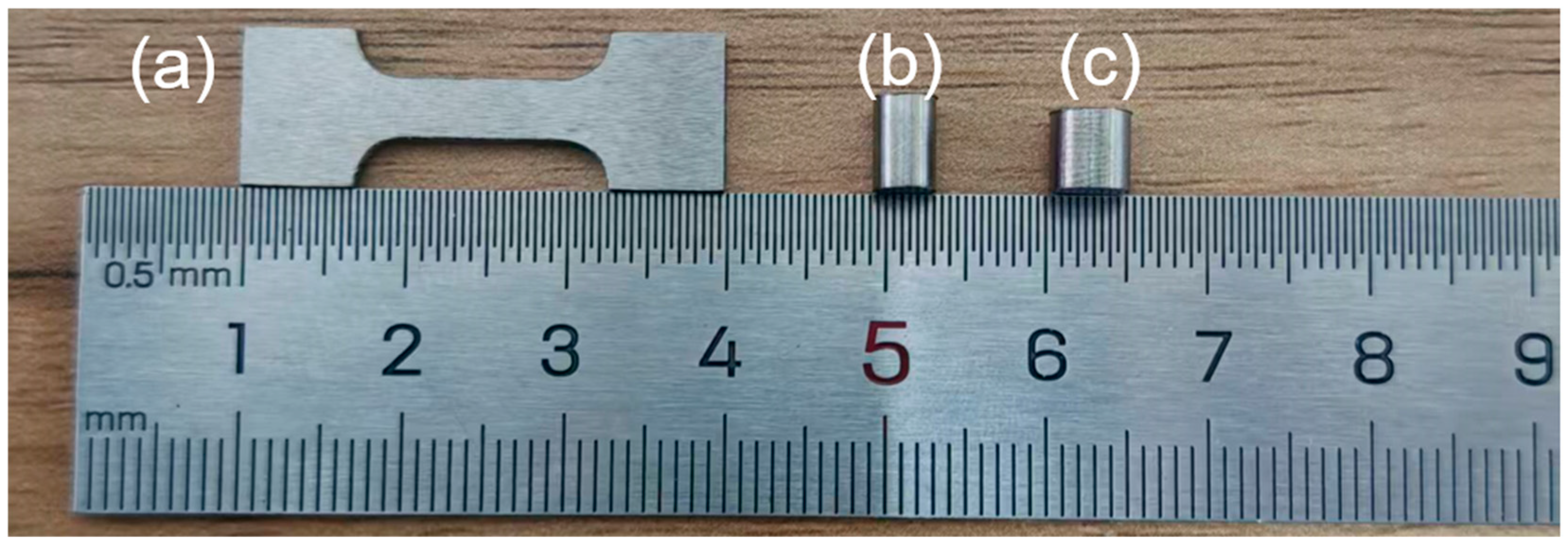
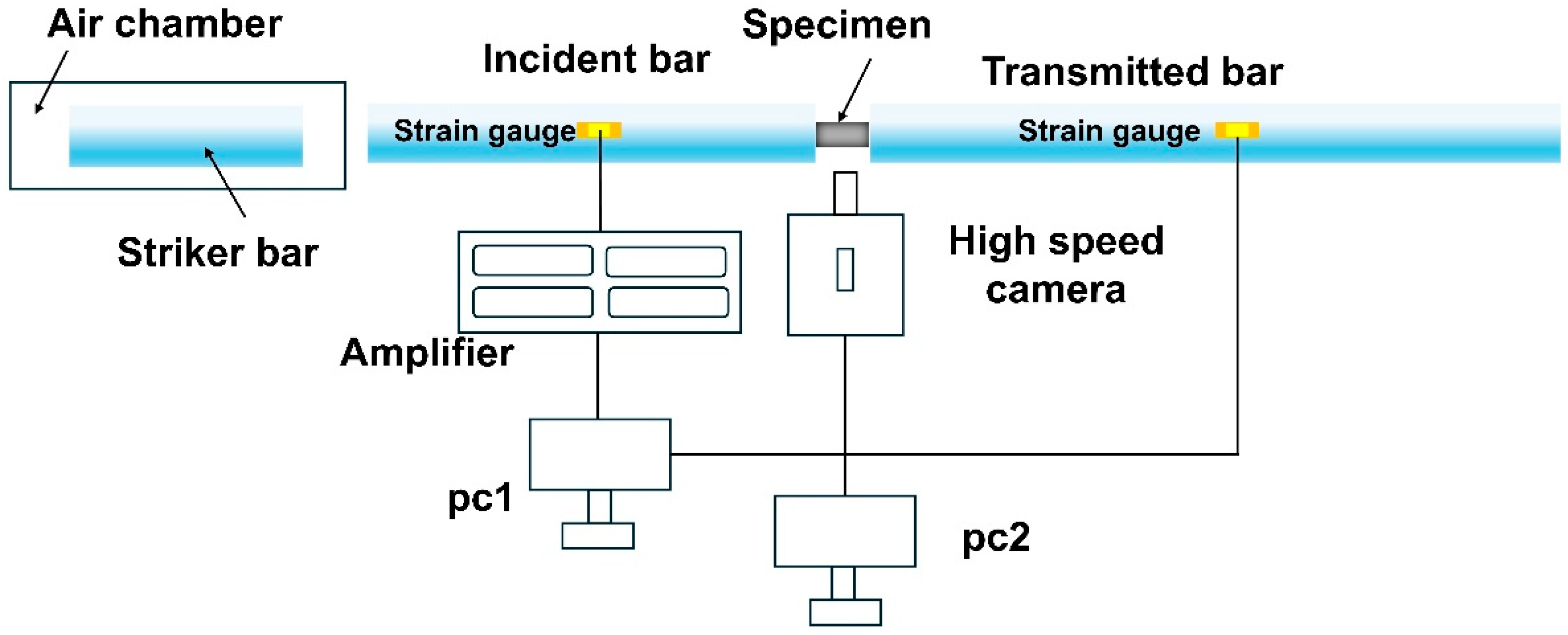
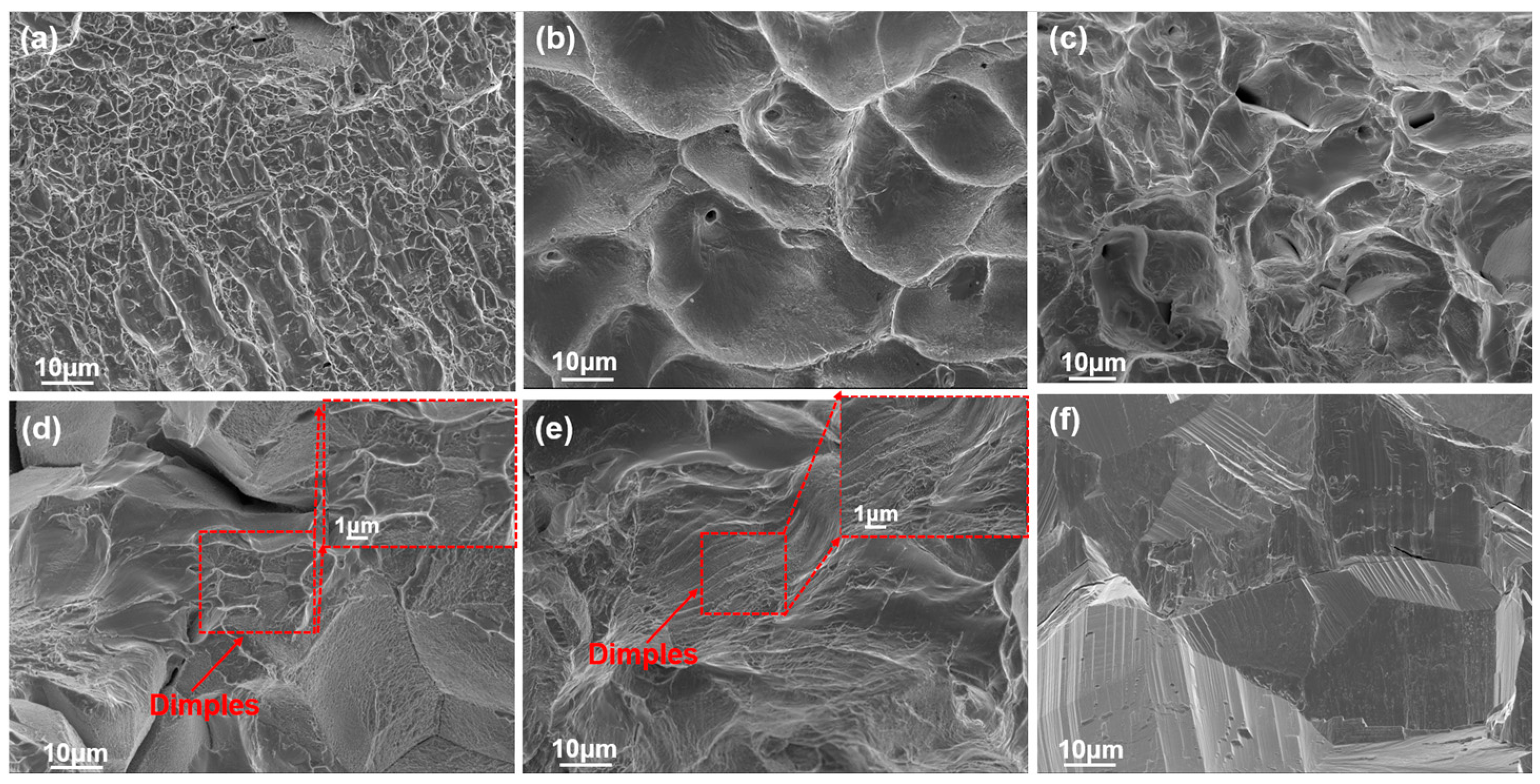
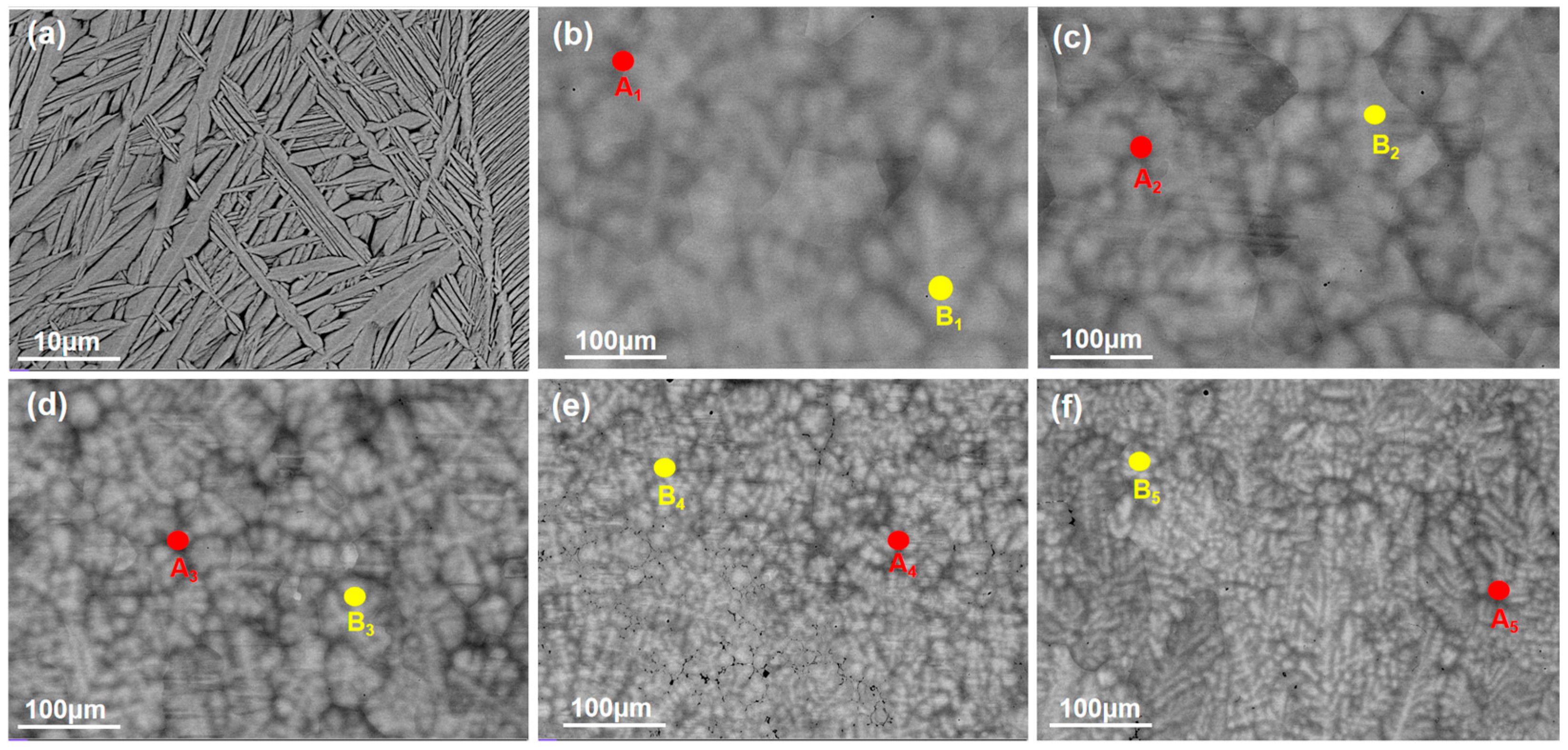
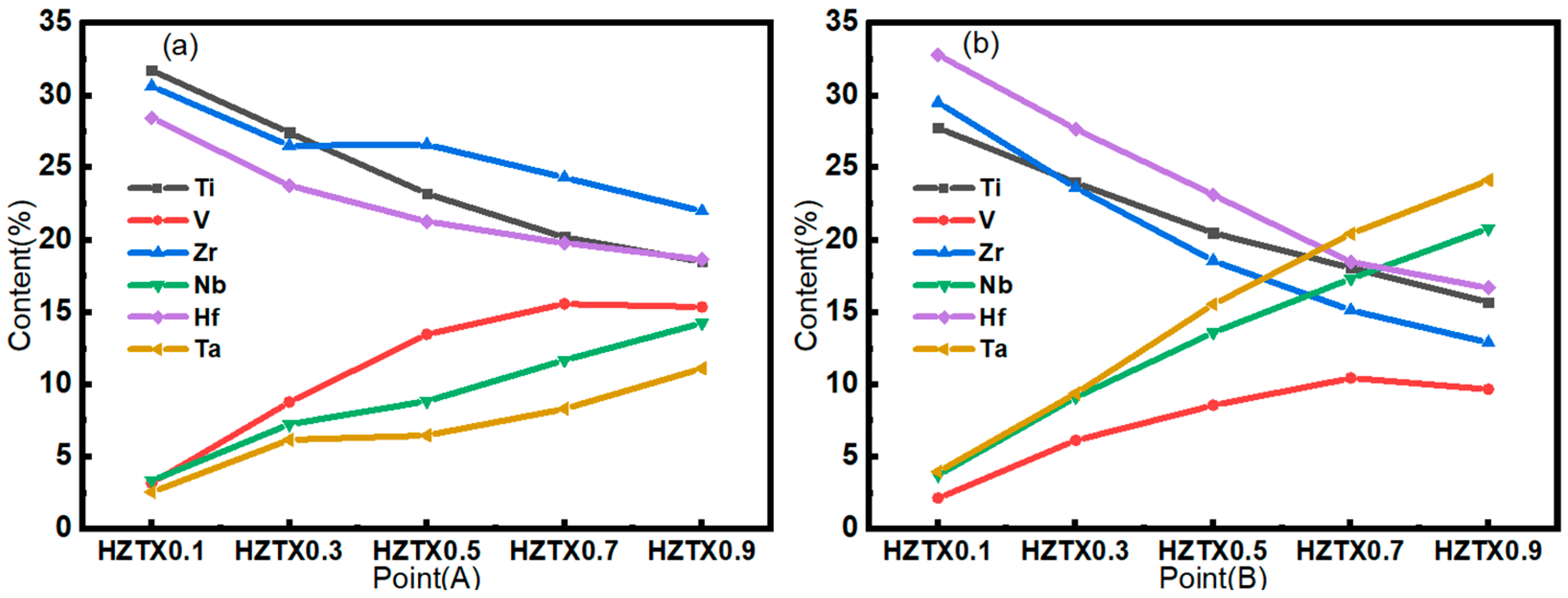
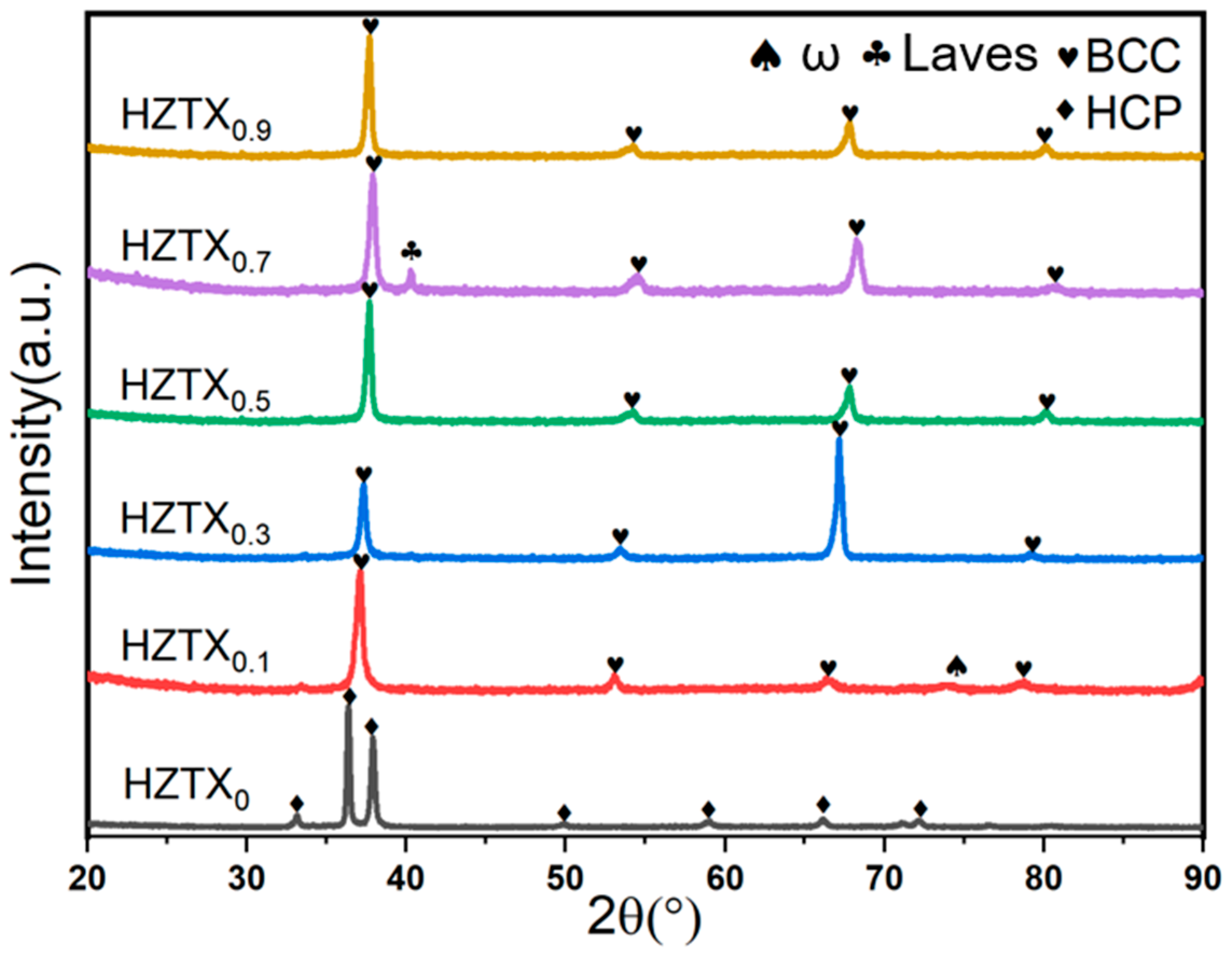
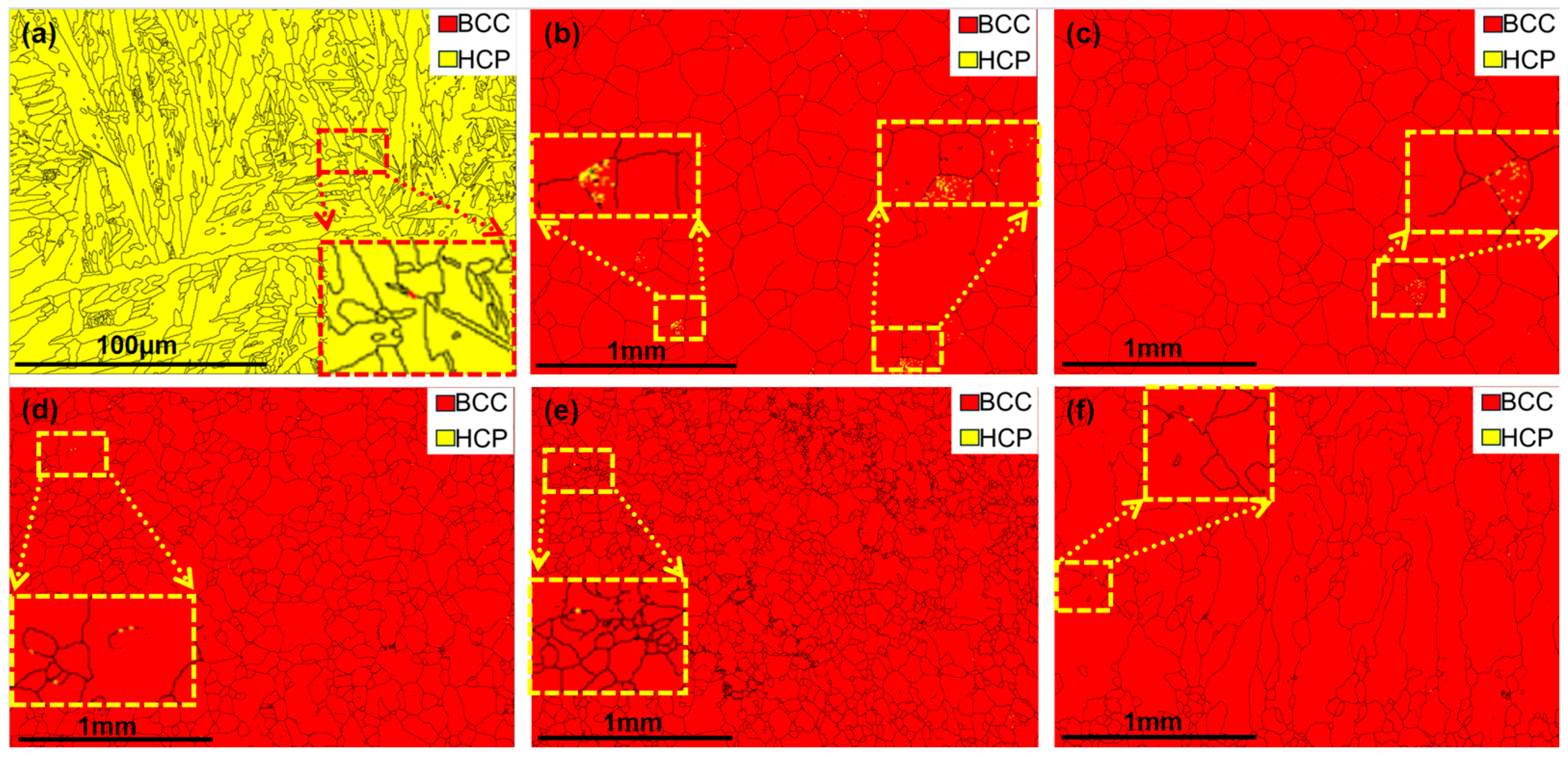
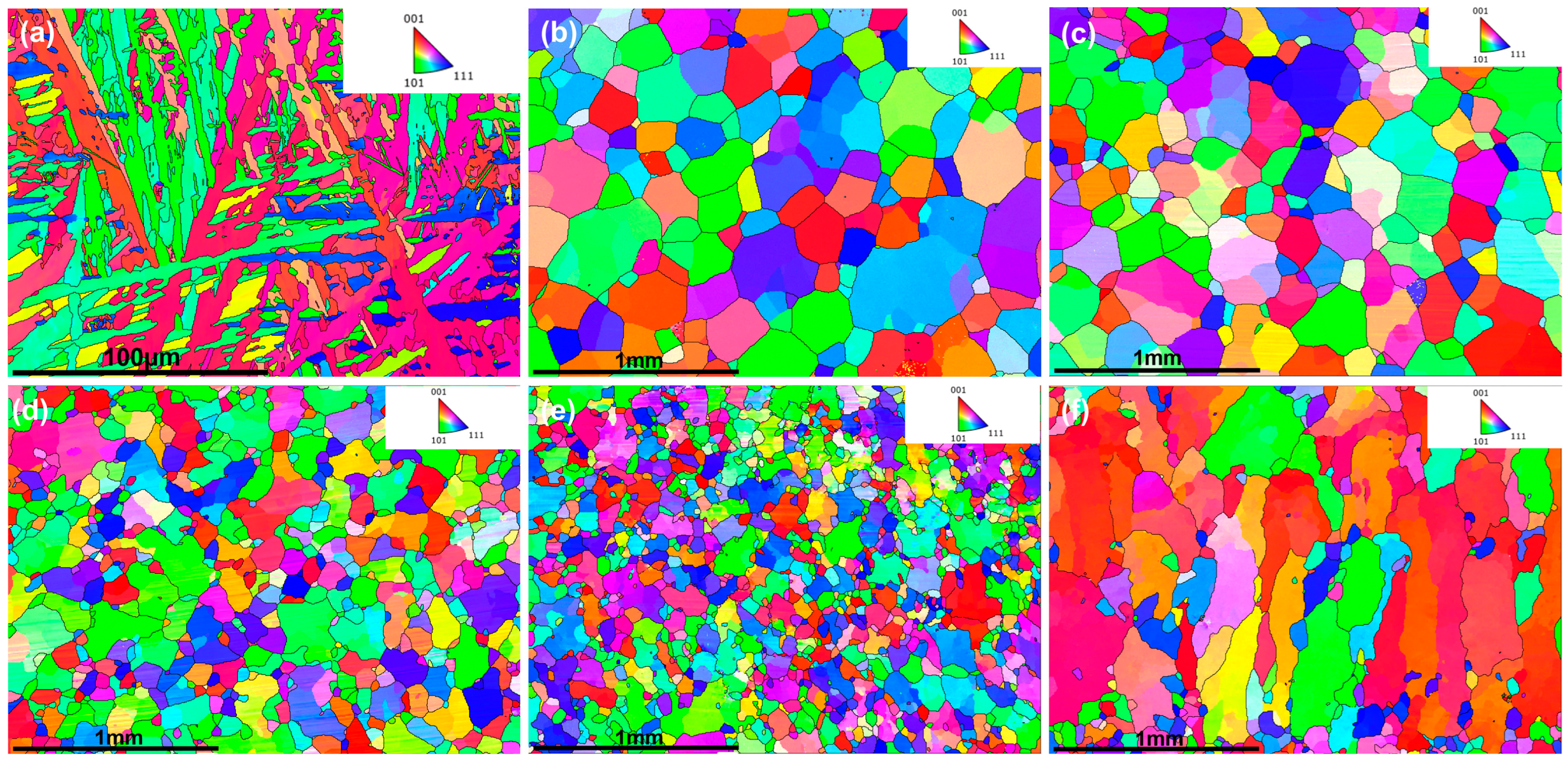

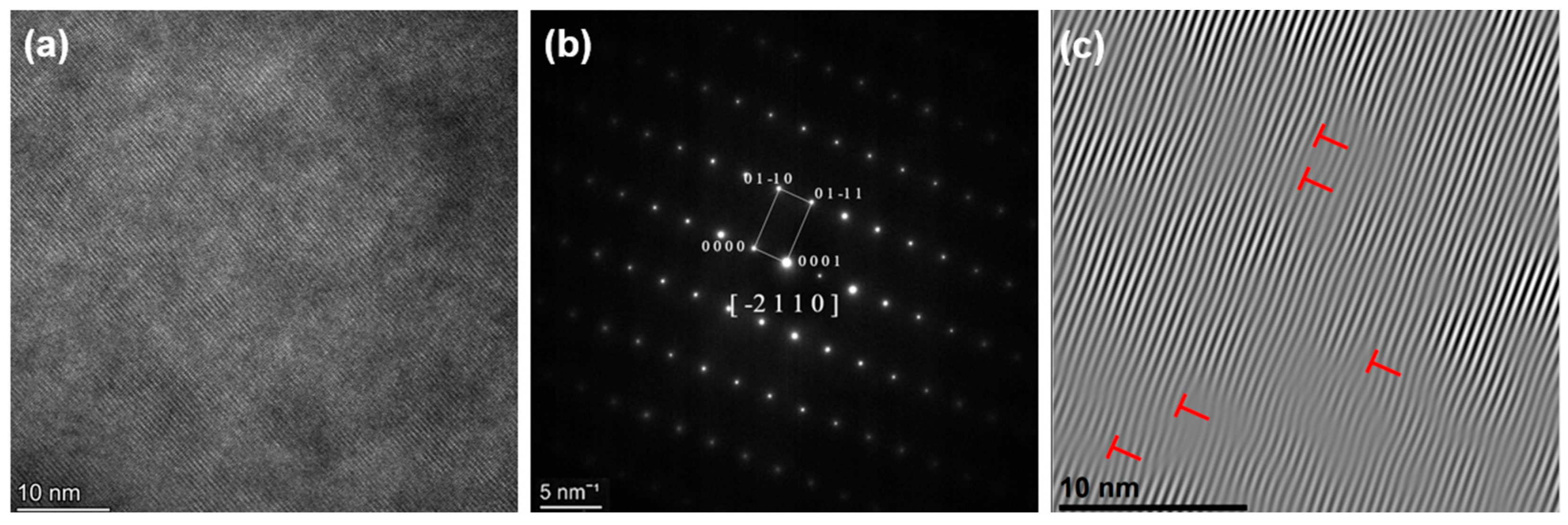
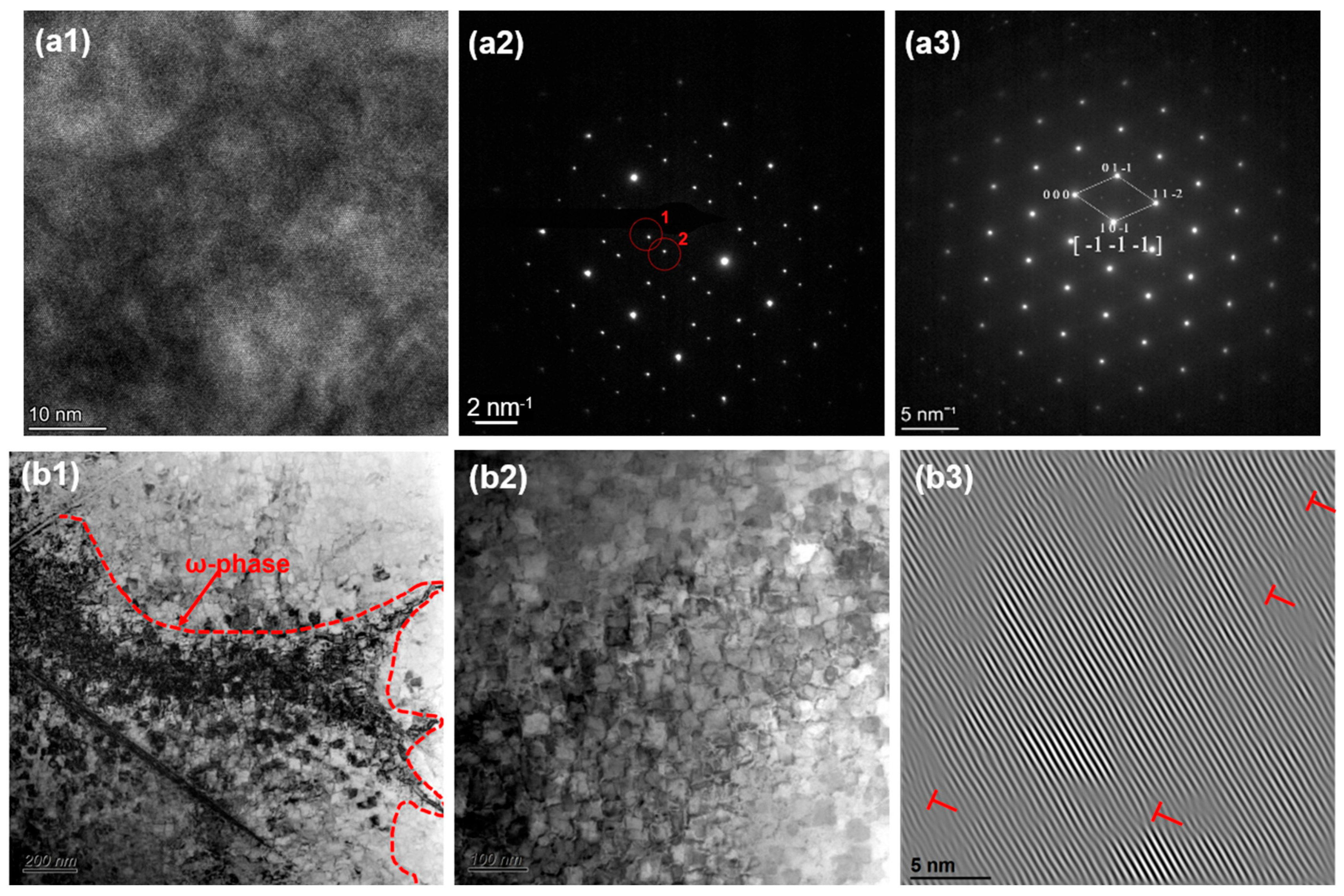
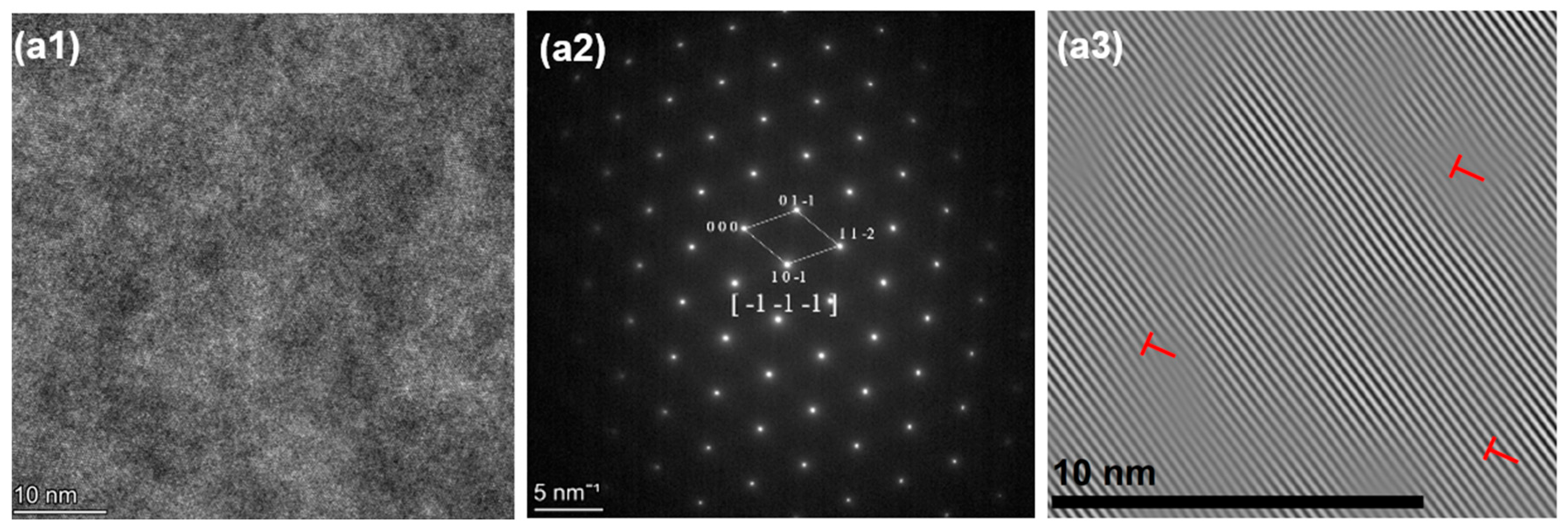
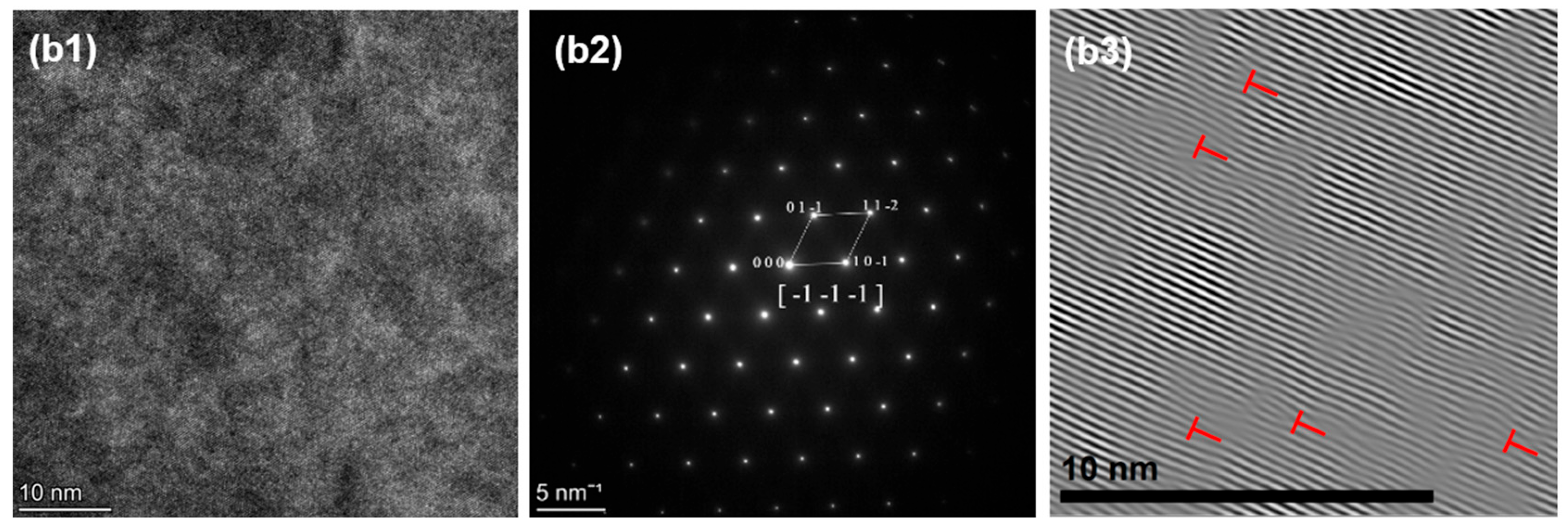
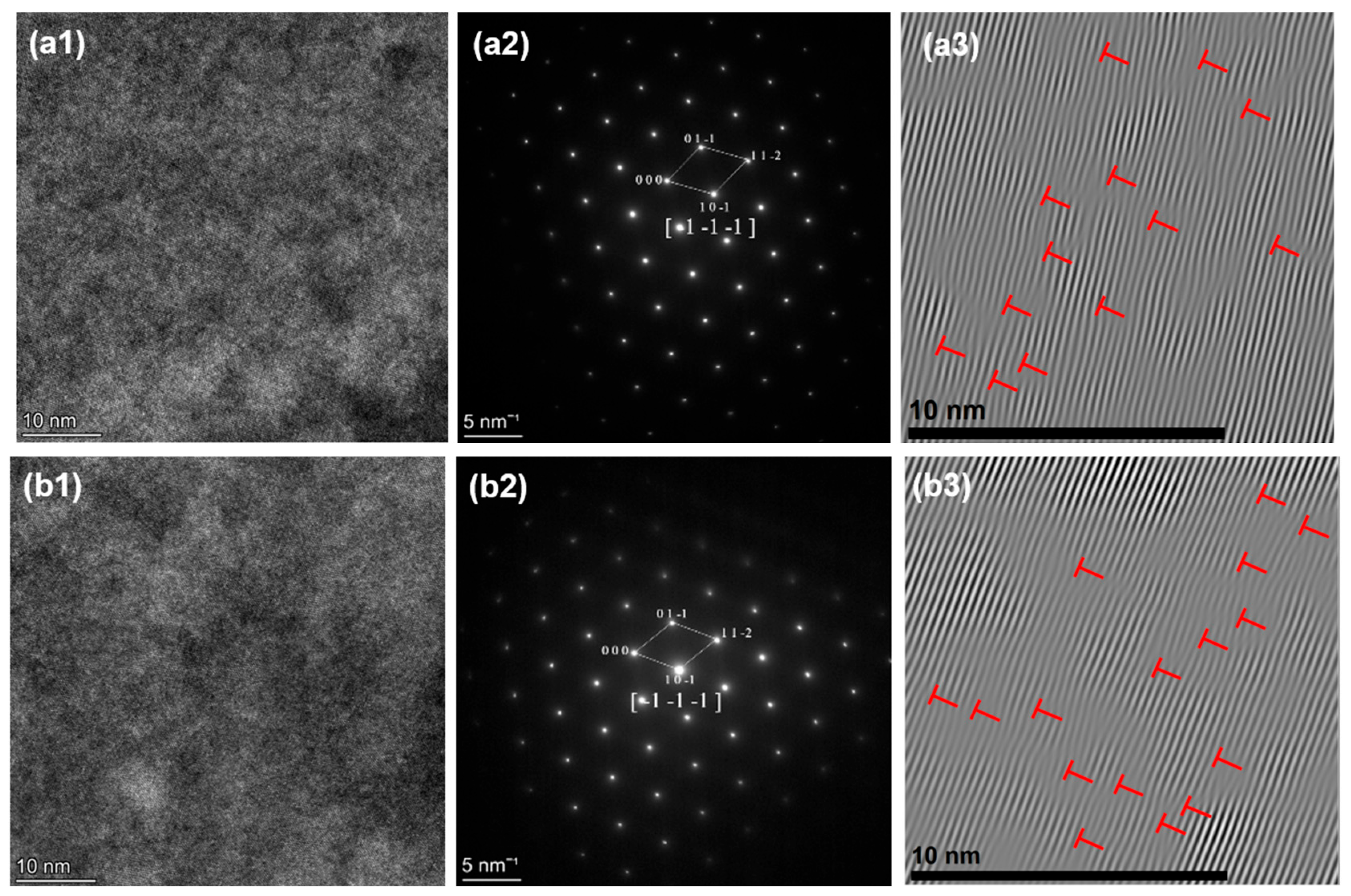
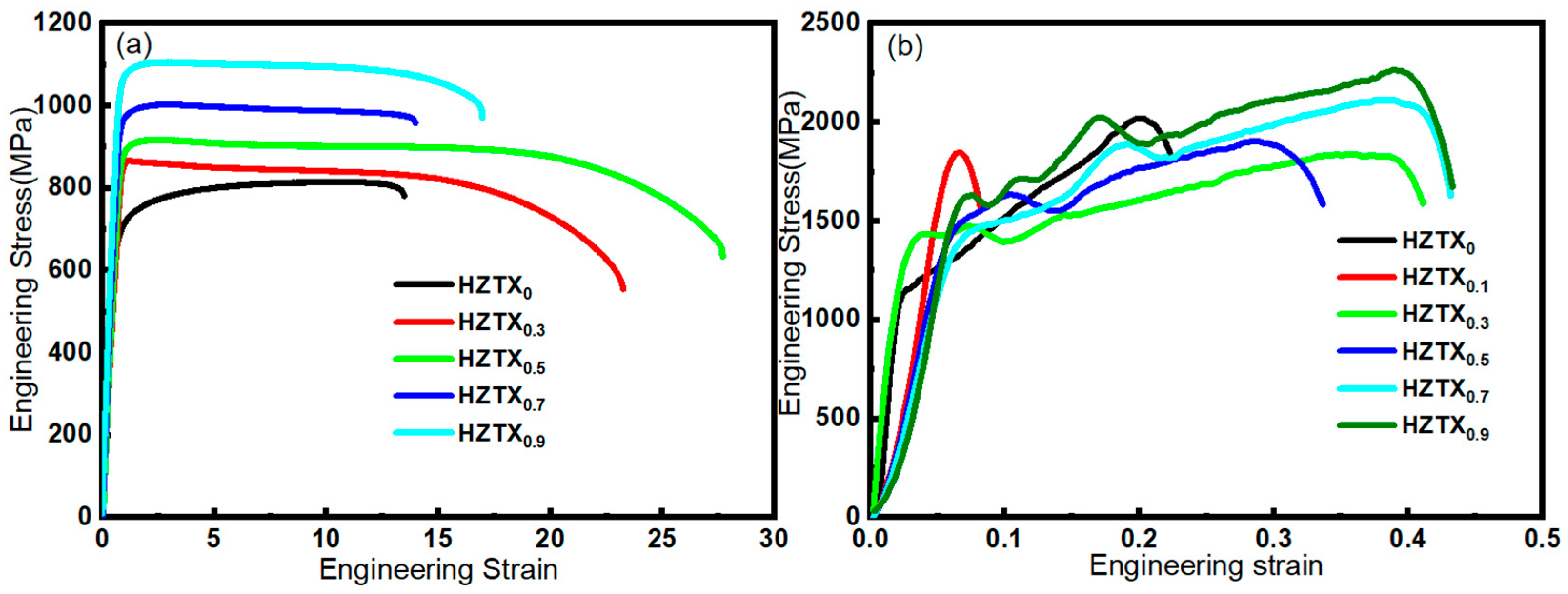

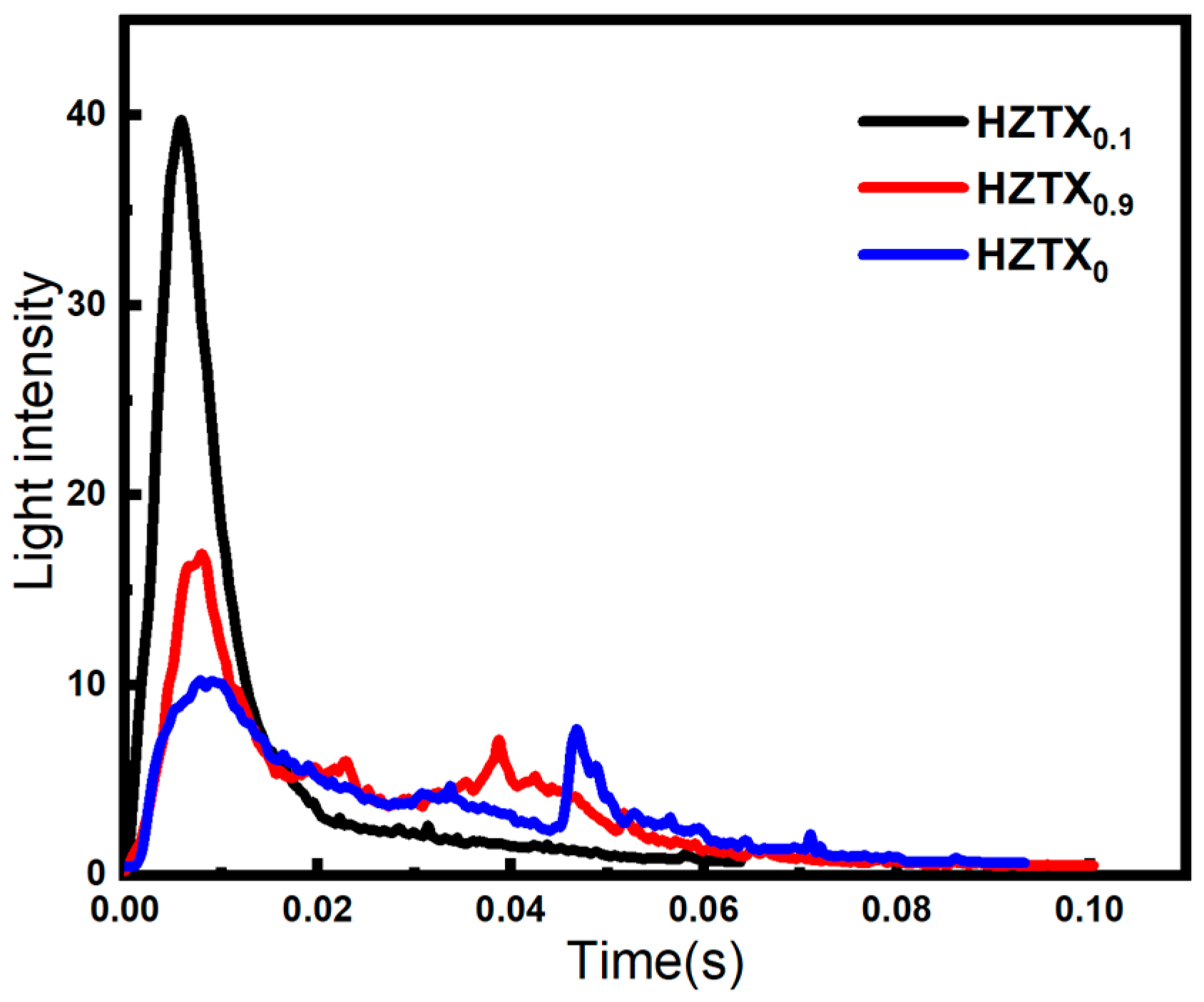
| Category | Yield Strength (MPa) | Ultimate Tensile Strength (MPa) | Elongation at Fracture (%) |
|---|---|---|---|
| HZT | 642 | 811 | 13.5% |
| HZTX0.3 | 830 | 869 | 22.0% |
| HZTX0.5 | 894 | 934 | 27.3% |
| HZTX0.7 | 963 | 1011 | 12.3% |
| HZTX0.9 | 1065 | 1119 | 16.4% |
Disclaimer/Publisher’s Note: The statements, opinions and data contained in all publications are solely those of the individual author(s) and contributor(s) and not of MDPI and/or the editor(s). MDPI and/or the editor(s) disclaim responsibility for any injury to people or property resulting from any ideas, methods, instructions or products referred to in the content. |
© 2025 by the authors. Licensee MDPI, Basel, Switzerland. This article is an open access article distributed under the terms and conditions of the Creative Commons Attribution (CC BY) license (https://creativecommons.org/licenses/by/4.0/).
Share and Cite
Chen, C.; Ma, Y.; Wei, M.; Gai, X.; Peng, Y.; Mei, Y.; Liu, X.; Zhang, K.; Li, J. Influence of Increased TaNbV on the Microstructure, Mechanical Properties, and Energy Release Characteristics of High-Entropy Alloy HfZrTi(TaNbV)x. Materials 2025, 18, 4713. https://doi.org/10.3390/ma18204713
Chen C, Ma Y, Wei M, Gai X, Peng Y, Mei Y, Liu X, Zhang K, Li J. Influence of Increased TaNbV on the Microstructure, Mechanical Properties, and Energy Release Characteristics of High-Entropy Alloy HfZrTi(TaNbV)x. Materials. 2025; 18(20):4713. https://doi.org/10.3390/ma18204713
Chicago/Turabian StyleChen, Chong, Yusong Ma, Manhui Wei, Xiqiang Gai, Yue Peng, Yanqi Mei, Xinglong Liu, Kaichuang Zhang, and Jianbin Li. 2025. "Influence of Increased TaNbV on the Microstructure, Mechanical Properties, and Energy Release Characteristics of High-Entropy Alloy HfZrTi(TaNbV)x" Materials 18, no. 20: 4713. https://doi.org/10.3390/ma18204713
APA StyleChen, C., Ma, Y., Wei, M., Gai, X., Peng, Y., Mei, Y., Liu, X., Zhang, K., & Li, J. (2025). Influence of Increased TaNbV on the Microstructure, Mechanical Properties, and Energy Release Characteristics of High-Entropy Alloy HfZrTi(TaNbV)x. Materials, 18(20), 4713. https://doi.org/10.3390/ma18204713






